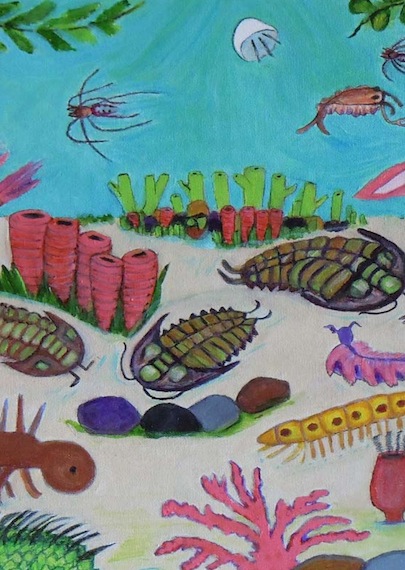cambrian explosion

542 Million years ago there was an explosion. It was a huge explosion. Like nothing that had been seen before on this little planet of ours. It wasn’t an asteroid strike or a volcano but an explosion in the variety and forms of life that teemed in our seas. This is referred to as the Cambrian Explosion as it ushered in the Cambrian geological era. One little innovation – skeletons and hard body parts – drove a huge diversification that took place in an evolutionary blink of an eye.
Prior to this innovation all life on earth had been a pretty dull affair. For a couple of billion years or so life was basically single celled, microbial sludge. As time wore on some slightly more interesting forms of life appeared on the scene which took the form of big wavy fronds that sat on the ocean floor wafting around in a general fashion sifting nutrients out of the water. A bit like a collection of bad haircuts growing out of the bottom of the sea. Then something changed and bang; life as we know it, with little critters chasing each other round, eating, fighting, shagging etc. really got going.
Why am I banging on about this? Well I often hear people asking ‘where is the next new thing’ coming from in dance music. The new Jungle, the new Dubstep, the new era defining genre. Well that got me thinking about how these new forms take shape.
All these sub genres are basically a collection of stylistic forms that are common across selection of music which is often produced by a group of loosely connected, like minded people who share a cultural viewpoint/references (loosely translated as a scene’) Pretty much all dance music is made up from the same elements using the same process i.e. drums, samples, synthesizers, bass lines, computers etc. and have the same function (i.e. for people to listen to/dance to). This is very much the same as a donkey and a chinchilla. Both are made using the same building blocks (skin, teeth, blood, guts) and have the same function (eating, fighting, shagging etc.) Jungle and handbag are made up of the same stuff, just arranged in a different way. Donkey’s and chinchillas are made up of the same stuff but just arranged in a different way.
You can directly relate the attributes of electronic music to the attributes of the little critters that burst onto the scene in the Cambrian Explosion. A 2 step rhythm, wobbling low bass, scattered and delayed percussion. Hard carapace, claws and a tail. Amen break, b-line and ragga mc. Long body, mouth, gut, anus. On the one hand new musical forms were made possible by (and constrained by) synthesizers and drum machines, on the other new body parts/functions (like teeth or jaws) made possible by hard skeletons.
There are a number of ideas as to why the Cambrian Explosion happened. Among these are the development of sight, and an arms race between predator and prey. If you’re a single celled creature just sitting on the bottom of the ocean absorbing nutrients and occasionally splitting yourself and all of you genetic information in two to create more buddies, then there’s not much pressure forcing you to adapt. But one little alteration in the playing field and suddenly evolution picks up dizzying speed, utilising the new tricks its learned like building hard body parts. Suddenly lots of new evolutionary niches opened up that did not exist before and life filled them up like a hungry badger with a can of whipped cream.
Beginning at the end of the 70s and continuing through the 80s and 90s, electronic music equipment got smaller, cheaper and more readily available. Also, more importantly, the development of MIDI in 1982 meant that you didn’t even need any musical training to sequence music. You didn’t need to learn an instrument, you could just tap away at buttons on a machine until it sounded right. Just think of Marshall Jefferson recording the pianos for his House Music Anthem at 45bpm and then speeding it up to 122bpm to make it sound like he could actually play. This equipment got into the hands of people already heavily involved in music but who wouldnt have previously had the resources to make a record. In the club scenes of New York, Chicago, and Detroit the music that we now know as house and techno emerged. This in turn filtered across the Atlantic and as it did electronic dance music went through its own Cambrian Explosion. A small collection of innovations, coupled with a broad habitat with lots of evolutionary niches lead this new music to evolve and adapt into different forms to fill each and every one.
When this music first reached Europe it was basically all just house music or techno or a bit of both. But within a couple of years this music was already fracturing into myriad different forms. Hardcore, Jungle, Bleep ‘N’ Bass, Handbag, Trance, Ambient, Speedcore, the list goes on. As house and techno spread out across the world it collided and interbred with music and scenes from other cultures. Multi directional cross pollination which in turn increased the speed at which new forms emerged. The new tools of cheap electronic music production equipment allowed dance music to adapt into a massive range of new forms to fill up every possible niche in an open ecological landscape.
After the Cambrian Explosion this rapid pace of evolution did not keep up forever. After a mad initial dash to fill niches the process slowed down, each new form that filled one evolutionary niche or other continued to develop, refine, tweak, but not at the eye watering pace as before. There were subsequent explosions; the development of land based plants for example when life made its way out of the sea and there was a sudden evolutionary explosion to fill all of the new niches to be found on land. Or there is the development of flowering plants which lead to a sudden evolutionary blooming (sorry). Both of these examples were triggered by a new innovation or change in environment but after a brief evolutionary gold rush the pace slows down again.
In the same way, the rapid evolution of forms and genres in dance music has slowed. This does not mean development and creativity in music has stopped though, or even slowed down for that matter. Just that the rate of the creation of new distinct genres or species of dance music is not carrying on at the same dizzying pace as before. Of course there is tiresome, lazy music out there but it only takes the most cursory survey of the current crop of electronic music to see the sheer volume of high quality sounds left right and centre. Each genre continues to develop, to refine, to cross pollinate. And new genres do emerge, and will continue to emerge but at a slower rate.
There will be more explosions. They will be sudden, and they will come from somewhere no one is expecting and will be driven by a change in the cultural landscape or a sudden innovation (either artistic or technological) that reinvents the playing field completely. Just think there are approximately 1 billion Indians and 1 billion Chinese who are on a headlong dash for middle-class-hood. Also theres the Arab Spring. What if they all started to bang out techno tracks?
They probably already are.


















Must Reads
David Holmes – Humanity As An Act Of Resistance in three chapters
As a nation, the Irish have always had a profound relationship with the people of Palestine
Rotterdam – A City which Bounces Back
The Dutch city is in a state of constant revival
Going Remote.
Home swapping as a lifestyle choice
Trending track
Vels d’Èter
Glass Isle
Shop NowDreaming
Timothy Clerkin
Shop Now